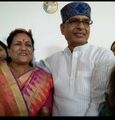Hoshangabad
| Author:Laxman Burdak, IFS (Retd.) |
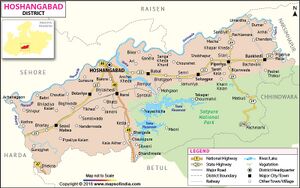
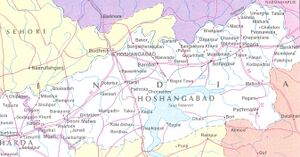
Hoshangabad (होशंगाबाद) is a city and district in Madhya Pradesh. It is now officially known as Narmadapuram. Hoshangabad city is located on the south bank of the Narmada River. The city is famous for the beautiful Sethani ghat along the banks of river Narmada.
Variants
- Narmadapur (नर्मदापुर)
- Narmadapuram (नर्मदापुरम)
Author's Visit
Author (Laxman Burdak) visited it on 09-10.09.1993, 12.03.1994, 09.07.1994, 27.09.1995, 19-20.01.1996.
Location
Hoshangabad city is located on the south bank of the Narmada River. Coordinates: 22.75°N 77.72°E. It has an average elevation of 278 m (912 ft). Northern boundary of the district is river Narmada. Across this the district of Raisen and Sehore lies. The district of Betul lies in the south, whereas the Harda district faces with the western and south-western boundaries and Narsinghpur and Chhindwara districts, close to the north-eastern and south-eastern sides of the district respectively.
History
The Hoshangabad city was earlier called Narmadapur after the river Narmada however later the name was changed to Hoshangabad after Hoshang Shah Gori, the first ruler of Malwa Sultanate.[1] Hoshangabad district was part of the Nerbudda (Narmada) Division of the Central Provinces and Berar, which became the state of Madhya Bharat (later Madhya Pradesh) after India's independence in 1947.[2]
The city was renamed to Narmadapuram in March 2021.[3]
Narmadapur mentioned in in Skanda Purana
Narmadapur is mentioned in Skanda Purana as abode of Jamadagni....
Jamadagni Receives Kamdhenu: Markandeya told Yudhishthir-' Sage Jamadagni was a great devotee of Shiva and he lived in Narmadapur. He spent his day chanting mantras in the praise of Lord Shiva. Once, he performed an austere penance, which lasted for a month. Ultimately, Shiva manifested himself from the Siddheshwar Linga and appeared before him. Lord Shiva asked Jamadagni to ask for any thing he wished for. Jamdagni expressed his desire to have Kaamdhenu so that he could perform his rituals and other religious obligations without any problem. Lord Shiva blessed Jamdagni and disappeared. The next moment, Jamdagni found Kaamdhenu standing in front of his hermitage.
Now, Jamdagni got everything that he wished for. This way, he was a happy and contented life until one fateful day when he was killed by a greedy king named Kartaveerya, who subsequently took Kaamdhenu along with him. While the greedy king was still on his way, Kaamdhenu cursed him that very soon not only he but the whole caste of Kshatriya would be liquidated by Parshuram- Jamdagni's son, as punishment for having committed such a ghastly sin of killing an innocent sage. After cursing Kartaveerya, Kaamdhenu went to her original abode-the heaven. Later on, when Parshuram learnt of his father's slaying, he liquidated Kartaveerya and the whole caste of Kshatriya as had been prophesized by Kaamdhenu.
Hoshangabad and Harda District Inscriptions
(81) Undikavatika Grant of Abhimanyu of 7th century
[p.58]: The inscription is undated, but on palaeographical grounds it is assignable to the 7th Century A.D., and is therefore of historical importance because it contains the earliest mention of Rashtrakuta (राष्ट्रकूट) kings. The princes here alluded to seem to have belonged to a branch distinct from that of the Malkhed (मालखेड़) family whose crest was the Garuda, while the seal of this grant bears a lion.
The genealogy begins with a king named Mananka (माणांक), the ornament of the Rashtrakutas. His son was Devaraja (देवराज), and his son again was Bhavishya (भविष्य) whose son was Abhimanyu (अभिमन्यु) . While the latter resided at Manapuram (मानपुरम) he granted a small village Undikavatika (उण्डिक वाटिका) to the (temple of) Dakshina-shiva (दक्षिण-शिव) belonging to (Petha) Pangaraka (पेठ पंगारक) in the presence of Jayasimha (जयसिंह) , the commander of the fort of Harivatsakotta (हरिवत्सकोट्ट).
The provenance of this inscription is not known, but it is held to belong to this province because the places mentioned in the record are identified by Dr. Fleet with those belonging to the Hoshangabad District. According to him
- Dakshina-shiva (दक्षिण-शिव) is the Mahadeva of Pachmarhi and
- Petha Pangaraka (पेठ पंगारक) is Pagara (पगारा) which is near it.
- Harivatsakotta (हरिवत्सकोट्ट) is identified with Dhupgarh (धूपगढ़), the highest peak of Pachmarhi, and
- Undikavatika (उण्डिक वाटिका) with Oontiya (ऊँटिया) or Untiya Shankar, a village 30 miles from Pachmarhi and 9 miles from Sohagpur. It is further suggested that
- Manapuram (मानपुरम) may be the present Manpur, near Bandhogarh, in Rewah, and that it must have been the capital of this branch of Rashtrakutas. But there is absolutely nothing else to support the theory that the Rashtrakutas ever ruled in Baghelkhand.
- Manapur may possibly have been a small village where Abhimanyu encamped when he made the grant, and it may now be nonexistent.
(Epigraphia Indica, Volume VIII, page 163 ff.; Indian Antiquary, Volume XXX, Page 509 ff, The Journal, Bombay Branch Royal Asiatic Society, Volume XVI, page 58 ff )
Wiki editors :
- Man (मान) (Jat clan) → Manapura (मानपुर)/Manapuram (मानपुरम) - mentioned in (81) Undikavatika Grant of Abhimanyu of 7th century. Manapur may possibly have been a small village where Abhimanyu encamped when he made the grant, and it may now be nonexistent.[4] Manapur was ancient historical village in Maharashtra which was the first capital of Rashtrakuta dynasty. It was probably located in Latura in Maharashtra. [5]
- Panghar (पांघर) (Jat clan) → Pangaraka (पंगारक) or Petha Pangaraka (पेठ पंगारक) mentioned in (81) Undikavatika Grant of Abhimanyu of 7th century has been identified as Pagara (पगारा). [6] Pagara (पगारा) is village in Pipariya tahsil in Hoshangabad district of Madhya Pradesh.
- Undikavatika (उण्डिक वाटिका): Undikavatika (उण्डिक वाटिका) is mentioned in '(81) Undikavatika Grant of Abhimanyu' of 7th century and has been identified with Oontiya (ऊँटिया), a village 30 miles from Pachmarhi and 9 miles from Sohagpur.[7]
(82) Timarni Idol Inscriptions of year 1146 AD, 1208 AD
[p.59]: Timarni is a station on the Great Indian Peninsula Railway, 51 miles from Hoshangabad. There are 3 broken idols giving the names of persons who had them made. One is that of Lakshmi Narayana, and is dated in Samvat 1203 (DA. 1146). The second is a Jain idol, dated in Samvat 1265 or A. D. 1208. The third is a Sivite idol mentioning Lajilal (लजिलाल), son of Sodhadeva (सोढ़देव). It is undated, but Sodhadeva may probably be the same mentioned in the inscriptions on the Padmakunda at Khandwa.
Wiki editor Note:
- Sodh (सोढ) (Jat clan) - Sodhadeva (सोढ़देव). Sodhadeva (सोढ़देव) (82) is mentioned in Timarni Idol Inscriptions of year 1146 AD, 1208 AD[8] reveals that there is a Sivite idol mentioning Lajilal (लजिलाल), son of Sodhadeva (सोढ़देव). It is undated, but Sodhadeva may probably be the same mentioned in the inscriptions on the Padmakunda at Khandwa.
(83) Charwa Inscriptions of year 1670 AD
[p.59]: Charwa is 44 miles from Hoshangabad. In an old temple (Guptesvara) at Haripura there is a record on a stone which reads as Champavatinagari. The local people are inclined to identify it with Charwa, but the record is not very old. It appears to be a pilgrim record, and Champavati may be the place whence the pilgrim came.
In the Mahalpura there is a step-well with an inscription dated in Samvat 1727 or A.D. 1670. It states that the well was built when the Emperor Aurangzeb was ruling and the local chief was Pratapa Shah.
Wiki editor Notes:
- Char (चार) (Jat clan) → Charwa (चारवा) is a village in Khirkiya tahsil of Harda district in Madhya Pradesh. In an old temple (Guptesvara) at Haripura there is a record on a stone which reads as Champavatinagari. The local people are inclined to identify it with Charwa.[9]
- Hari () (Jat clan) → Haripura Mal () is a village in Khirkiya tahsil of Harda district in Madhya Pradesh. In an old temple (Guptesvara) at Haripura there is a record on a stone which reads as Champavatinagari. The local people are inclined to identify it with Charwa.[10]
- Mahal (माहल) (Jat clan) → Mahalpura Mal () is a village in Khirkiya tahsil of Harda district in Madhya Pradesh. In the Mahalpura there is a step-well with an inscription dated in Samvat 1727 or A.D. 1670. It states that the well was built when the Emperor Aurangzeb was ruling and the local chief was Pratapa Shah.[11]
(84) Kapasi Statue Inscription of year 1491 AD
Is illegible. The date on it appears to be Samvat 1548 or 1491 A.D.
Wiki editor Notes
- Kapahi (कपही) (Jat clan) → Kapasi (कपासी) is a village in Rehatgaon tahsil in Harda district in Madhya Pradesh. It is site of (84) Kapasi Statue Inscription of year 1491 AD.[12]
(85) Sati Inscriptions.
Sohagpur and Umardha possess illegible Sati records which are of no importance.
Wiki editor Notes:
- Sohag (सोहाग) (Jat clan) → Sohagpur (सोहागपुर) is a village in Rehatgaon tahsil in Harda district in Madhya Pradesh. It possess illegible Sati records.[13]
- Umara (उमरा) (Jat clan) → Umardha (उमरधा) is a village in Rehatgaon tahsil in Harda district in Madhya Pradesh. Umardha possess illegible Sati records.[14]
Jat History
कैप्टन दलीप सिंह अहलावत[15] लिखते हैं कि भगवान् श्रीकृष्ण जी के पौत्र अनिरुद्ध के पुत्र बृज को, यादवों के आपस में लड़कर भयंकर विनाश होने पर, अर्जुन द्वारिका से लाया और उसे इन्द्रप्रस्थ की गद्दी पर बैठाया। इस यदुवंशी बृज के बड़े पुत्र खिर थे जिसके नाम पर इनकी परम्परा में खिरवार वंश प्रचलित हुआ। यह यदुवंशी जाट गोत्र है जो भाषाभेद से खरे भी कहा जाता है। महाराजा खिर का राज्य बृजमण्डल पर था अतः इस वंश के जाट आज भी बृज के अन्तर्गत आगरा जिले में ही रहते हैं। पथौली इस वंश की अच्छी रियासत रही। पंजाब में तरनतारन के समीप खण्डूशाह, सांगोकी, शेरों, उसभा, झाली, गोलावाड़ा, मानकपुरा इस वंश के प्राचीन आर्यों की बस्तियां हैं। मध्यप्रदेश में यह खिरवार शब्द खिनवाल नाम पर प्रसिद्ध हुआ। उधर इस वंश के जाटों ने हरदा होशंगाबाद में जाकर छत्रपति शिवाजी और उनकी परम्परा की युद्धों में सहायता की थी, जिसके कारण इनको भोंसला बहादुर की उपाधि से सत्कृत किया गया। राव जगभरथ ने नरसिंहपुर नामक नगरी को बसाया। इनकी परम्परा देर तक इस नगरी पर स्वतन्त्र शासन करती रही। इस खिरवार गोत्र के हिन्दू एवं सिक्ख जाटों ने समान प्रतिष्ठा प्राप्त की।
कैप्टन दलीप सिंह अहलावत[16]मध्यप्रदेश के रतलाम शहर में तथा आस-पास में, इन्दौर के चारों ओर होशंगाबाद की हरदा तहसील तथा नरसिंहपुर से करेली तक, भोपाल में 15 गांव, ग्वालियर के गोहद क्षेत्र में जाटों की बहुत अच्छी संख्या आबाद है।
Jat Gotras in Hoshangabad
Jat Gotras Namesake
- Chaura (चौरा) (Jat clan) → Chauragarh (चौरागढ़) is site of Chhota Mahadeo Shiva temple in Pachmarhi Hill station situated in the Satpura Ranges. It is in Hoshangabad district of Madhya Pradesh state of central India.
- Denwia (देनविया) (Jat clan) → Denwa River (देनवा नदी) is a river originating around Dhupgarh in Pachmarhi, Hoshangabad in the Indian state of Madhya Pradesh.
- Panghar (पांघर) (Jat clan) → Pangaraka (पंगारक) or Petha Pangaraka (पेठ पंगारक) mentioned in (81) Undikavatika Grant of Abhimanyu of 7th century has been identified as Pagara (पगारा). [17] Pagara (पगारा) is village in Pipariya tahsil in Hoshangabad district of Madhya Pradesh.
- Tawana (तावणा) (Jat clan) → Tawa River (तवा नदी). Tawa River (तवा नदी) is a tributary of the Narmada River of Central India. It rises in the Satpura Range of Betul and flowing north and west, joins the Narmada at the village of Bandra Bhan in Hoshangabad District.
Tahsils in Hoshangabad district
Villages in Hoshangabad tahsil
Agra Kalan Amupura Andhiyari Aonri Bai Khedi Baihara Khedi Bamhangaon Kalan Bamhangaon Khurd Bamhori Khurd Bamuria Barandua Barodia Kalan Barodya Khurd Biaora Budhwada Bundara Khurd Chandpura Dattapura Deshmohni Diwla Khedi Dolariya Dongarwada Dudugaon Gunaura Gwadi Khurd Hasalpur Horiya Pipar Hoshangabad (M) Jaitpur Jasalpur Kajlas Kandra Khedi Khar Khedi Kharar Khedi Ahir Khedla Khoksar Kulamdi Kulhda Maharaghat Misrod Mohari Mophada Mungwari Nanpa Nimsadiya Nitaya Nohar Palanpur Palasdoh Palasi Panjara Kalan Parradeh Pathodi Patlai Khurd Puwar Kheda Basti Puwarkheda Farm Raipur Randhal Ridhoda Rohna Rojhda Sail Saket Sawal Kheda Superli Talnagri Tarondadhana Tigaria Tugariya Undra Khedi
Notable persons
- Smt Maya Narolia - Chairman Nagar Palika Hoshangabad (M P ).[18] Mob: 9424434911
- Smt Meena Verma- ex Chairman, Nagar Palika Parishad, Hoshangabad-9826664194
- Devendra Verma, Govt. Service Mob. No. 9827255381
- Bhupendra Jat- Advocate- 7000400166
- Shailendra Jat, Gym. Trainer-6267742223
Gallery
-
Smt Meena Verma, ex chairman, Nagar Palika Parishad, Hoshangabad
-
Smt Maya Naroliya, ex Chairman, Nagar Palika Parishad, Hoshangabad with Shri Shiv Raj Singh Chohan, Chief Minister of MP
Population
Total population - 117988 Male - 61716 Female- 56272
Tourism
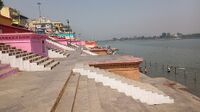
Sethani Ghat, Hoshangabad: Sethani Ghat is a 19th-century construction along the banks of the river Narmada at Narmadapuram in Madhya Pradesh in India. It is one of the largest ghats in India. During Narmada Jayanti celebrations the ghat comes alive when thousands of people converge on the ghats and diyas are floated in the river. The ghat was built after generous contributions by Jankibai Sethani from the Sharma family in Narmadapuram after devotees complained to her about the difficulty in getting to the river, Hence the ghat is named after her. It is one of the few examples of public infrastructure built through private funding in India.
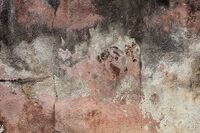
Adamgarh Rockshelters Hoshangabad: आदम गढ़ एक अति प्राचीन स्थान है। यहाँ स्थित प्राचीन पत्थरों पर की गई चित्रकारी (Petroglyph) के लिये आदम गढ़ बहुत प्रसिद्ध है। आदम गढ़ मध्य प्रदेश राज्य के होशंगाबाद नगर से 2 कि.मी. दूर नर्मदा नदी के पास स्थित है। आदम गढ़ पहाड़ी की गुफ़ाओं में की गई चित्रकारी में पाषाण युगीन सभ्यता के अवशेष आसानी से देखे जा सकते हैं। भारतीय पुरातत्व सर्वेक्षण (एएसआई) के नियंत्रण के तहत प्राचीन स्थानों में से एक आदम गढ़, विश्व प्रसिद्ध भीमबेटका गुफ़ाओं से क़रीब 40 कि.मी. दूर है। आदम गढ़ में 20 चट्टानी आश्रय चित्रकारी से सजे हैं जो लगभग 4 कि.मी. के क्षेत्र में फैले हुए हैं। आदम गढ़ की पहाड़ियों में बने चित्रित चट्टानी आश्रय पाषाण काल तथा मध्यपाषाण काल के हैं। इस कला स्थल का खुदाई सामग्री से पता लगाया गया है। [19]
External links
Source
- Santosh Kumar Thakur (Khenwar) 9826546968
References
- ↑ Hoshangabad District Census Handbook
- ↑ Hunter, William Wilson, Sir, et al. (1908). Imperial Gazetteer of India, Volume 6. 1908-1931; Clarendon Press, Oxford
- ↑ "MP: Private Bill to rename Hoshangabad district passed". The Indian Express. 6 March 2021.
- ↑ Hira Lal:Descriptive lists of inscriptions in the Central provinces and Berar, Nagpur, 1916, p.58 (S.No.81)
- ↑ Aitihasik Sthanavali by Vijayendra Kumar Mathur, p.734
- ↑ Hira Lal:Descriptive lists of inscriptions in the Central provinces and Berar, Nagpur, 1916, p.58 (S.No.81)
- ↑ Hira Lal:Descriptive lists of inscriptions in the Central provinces and Berar, Nagpur, 1916, p.58 (S.No.81)
- ↑ Hira Lal:Descriptive lists of inscriptions in the Central provinces and Berar, Nagpur, 1916, p.59 (S.No.82)
- ↑ Hira Lal:Descriptive lists of inscriptions in the Central provinces and Berar, Nagpur, 1916, p.59 (S.No.83)
- ↑ Hira Lal:Descriptive lists of inscriptions in the Central provinces and Berar, Nagpur, 1916, p.59 (S.No.83)
- ↑ Hira Lal:Descriptive lists of inscriptions in the Central provinces and Berar, Nagpur, 1916, p.59 (S.No.83)
- ↑ Hira Lal:Descriptive lists of inscriptions in the Central provinces and Berar, Nagpur, 1916, p.59 (S.No.84)
- ↑ Hira Lal:Descriptive lists of inscriptions in the Central provinces and Berar, Nagpur, 1916, p.59 (S.No.85)
- ↑ Hira Lal:Descriptive lists of inscriptions in the Central provinces and Berar, Nagpur, 1916, p.59 (S.No.85)
- ↑ Jat History Dalip Singh Ahlawat/Chapter XI, p.1024
- ↑ Jat History Dalip Singh Ahlawat/Chapter II , p. 69
- ↑ Hira Lal:Descriptive lists of inscriptions in the Central provinces and Berar, Nagpur, 1916, p.58 (S.No.81)
- ↑ Jat Samaj, January-February 2010, p. 52
- ↑ भारतकोश-आदम गढ़
Back to Places



